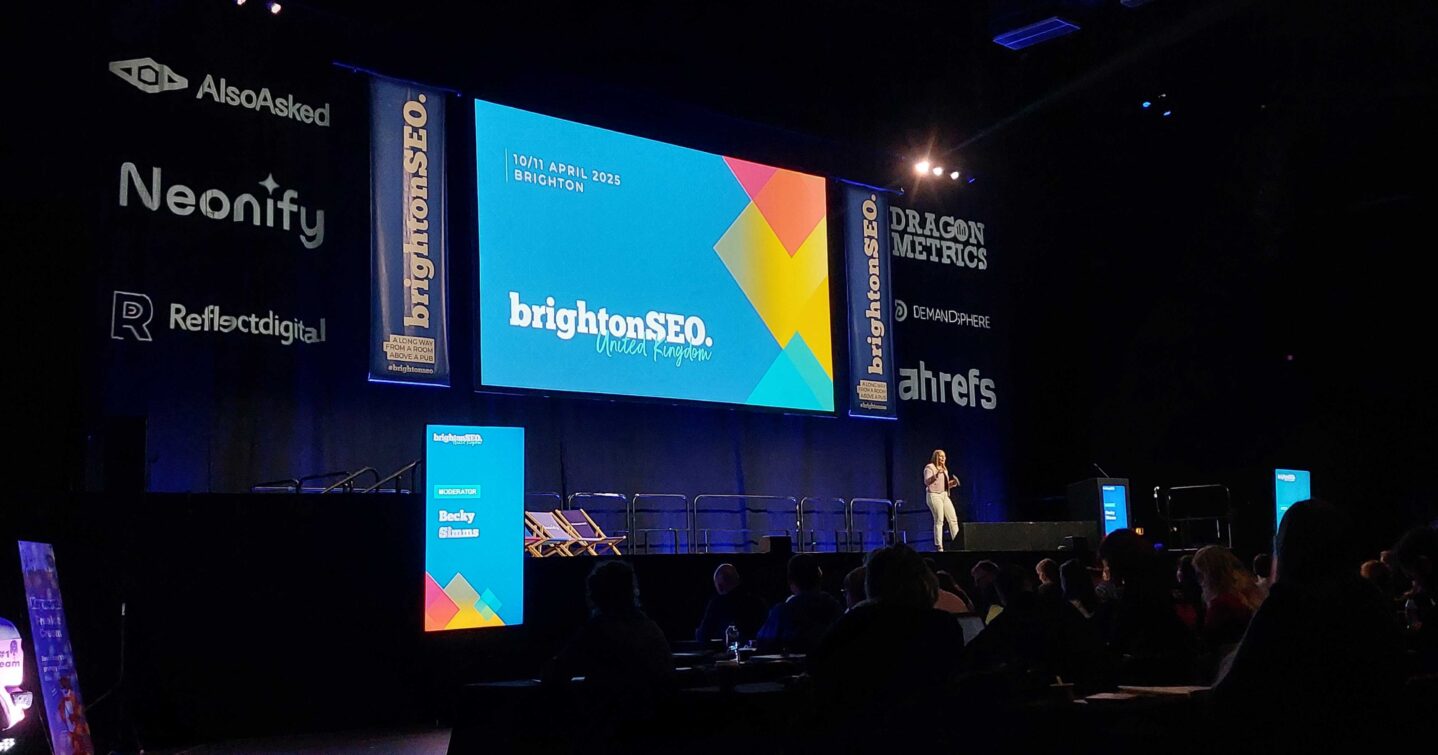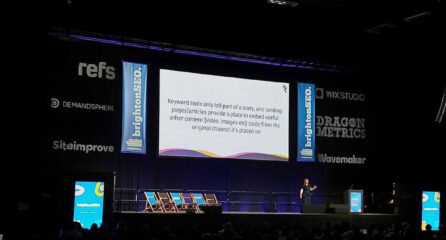There’s only one thing on our mind when April comes round – and we’re not talking about Easter eggs. We’re talking about BrightonSEO.
Jack and Chloe, part of our Organic division, represented Loom Digital this year, learning more about industry updates and developments to incorporate into our SEO and Content work. We’ve summarised their highlights below.
Our takeaways from April’s BrightonSEO
AI, accessibility, data and the state of SEO were front and centre at this year’s conference. And it’s not surprising – artificial intelligence has been making waves throughout the industry, while the recent privacy legislation updates kept businesses on their toes.
We at Loom support our clients through these changes, sticking by their side as we navigate a particularly turbulent and fast-changing landscape. Standing out in their respective industries is key to thriving, and BrightonSEO certainly provided Jack and Chloe with new ways of helping our clients do just that.
Taking content audits to the next level
Talk: Fuelling the eCommerce growth engine: Reporting that drives smarter decisions
Speaker: Kieran Wright
As SEO’ers, we all rely on a pool of tools for data collection, such as Ahrefs, Screaming Frog, GA4, and SEMrush. But what happens when you bring these tools together? Stronger, more valuable insights that can take content audits to the next level.
Kieran took us through ways of combining our tools to create various Looker reports. One that stood out was a tool blend that provides a percentage comparison of page speed, sentence and word counts or Flesch readability score between your site, the industry average, and/or key competitors. So, if you want to compare your blog loading times to the rest of your industry, simply export your URLS and crawl via Screaming Frog, which you can connect to the Page Speed Insights API. Export the data into a Google Sheet once the crawl is complete, and then input into Looker Studio.
Kieran then provided us with Sheets formulas that analyse these Page Speed metrics against averages for the rest of your website, your industry, and even competitors. At the end of this, you’ll have a content dashboard in Looker that helps you keep track of key performance metrics, which can inform your content optimisation strategy.
“Content audits have always been a key part of our strategies – it’s how we know that our content efforts are paying off. Switching these audits to Looker Studio and having live reports for certain metrics is a game changer for me. It means less time exporting data from various tools into one large sheet, and provides us with a more digestible report that we – and our clients – can turn to whenever we need it.” – Chloe, content writer at Loom
The European Accessibility Act
Talk: Google is blind – what this means in 2025
Speaker: Clive Loseby
We all know that accessibility is important, and with the new European Accessibility Act coming into effect on June 28th 2025, there will be a legal requirement to make your website accessible. This may be an EU legislation that won’t be rolled out to the UK, but it does apply to all businesses that sell or ship products to the European Union. You can find out more about the legislation here.
But this Act shouldn’t be your only motivation for ensuring your site is accessible for everyone. All users have the right to navigate the web safely and securely. As businesses, we aim to make life easier for our customers, clients and partners. By not providing a smooth, comfortable user journey for all, you risk alienating some of your target audience.
Clive listed some of the common accessibility mistakes that we often see online:
- Relying on the ‘C’ word for anchor text – which, in this case, means ‘Click here.’ We all know that generic anchors do not align with SEO best practices, but for those who are visually-impaired, you may rely on anchors to tell you where you’re clicking. ‘Click here’ will tell you very little.
- Colour contrast – this refers to the ratio of foreground to background colours on your website (excluding company logos), ensuring that users can clearly understand content and are not affected by certain colours used.
- Focus – following on from colours, you also want to consider how buttons, links and visuals appear as users interact with them. If someone is unable to use a mouse and relies on keyboard shortcuts, they need to know where abouts on the page they’re currently reading and clicking. This can be as simple as having certain elements change colours when hovering over them.
“The purple pound (spending power of those with accessibility needs) is £274 billion and $8 trillion worldwide. With the impending European Accessibility Act soon to be implemented, it’s more important than ever that businesses make sure they’re compliant and providing a safe user journey for all users.” – Jack, our tech SEO expert.
AI search engines vs Google
Talk: The new world of AI optimisation and how it differs from SEO
Speaker: Marcus Tober
AI search engines are growing in popularity, and while Google still dominates the search market, we’re seeing referral traffic from these search engines appearing in some of our clients’ reports. This shows that now’s the time to consider optimising for AI search tools like ChatGPT, Gemini and Perplexity. Marcus has taken a deep dive into AI tools and how they compare to the big players, Google and Bing.

Market share
Let’s start with market share. Marcus compared Perplexity’s traffic to DuckDuckGo, who own just 0.79% of the current market share. This talk showed that, while AI search is rising, the number of Perplexity and Gemini users is still miles behind search engine DuckDuckGo – who are also miles behind Google.
ChatGPT, however, is gaining significant traction. They’ve overtaken DuckDuckGo in terms of users – but don’t panic yet, AI sceptics. The AI tool is yet to beat Bing, whose own market share is growing.
Small vs large domains
AI search engines, including ChatGPT, tend to rank smaller domains, whereas Google seems to prefer larger sites. If you’re a big brand and want to rank in one of these smaller search engines, AI will likely rely on third-party sources to provide information about your business to users, rather than your site itself.
But what are these sources? They could be reviews, news and PR articles, and social media activity related to your business. All the more reason to ensure your brand reputation is up to scratch.
It’s also worth noting that AI search engines are unable to render JavaScript. This means that, if you ask an AI search engine, such as Perplexity, to crawl a website that relies heavily on JavaScript, the tool is unable to view your site correctly. Instead, it will see strange formatting, white space and content that may not fully load. So, if a user asks questions about your brand via AI search, the tool may once again turn to third-party sources for answers, as it does not have a strong understanding of your website.
“Right now, there’s a lot of talk that SEO is dead and keywords no longer matter. We can see from the above statistics that this isn’t true (for now, at least!). While AI search is gaining traction, Google is still the go-to search engine for many, and you shouldn’t give up on your SEO efforts.” – Chloe
Back to basics: Alt Text
Talk: What the f*** is Alt Text
Speaker: Liam Cumber
Although alt text is often overlooked and is considered a low priority in terms of SEO, it can still be very beneficial for accessibility reasons. If you’re not adding alt text to images, or using it for only company data i.e. photoshoot dates, you may not be providing the information that some users need.
Liam provided a deep dive into how exactly we should be writing alt text. While this may seem like a basic SEO tactic to many, it’s always good to revisit the basics and ensure that we’re providing the search experience our customers deserve. We’ve already mentioned that accessibility is about to become more of a priority for many businesses, so now’s the time to brush up on your alt text practices.
Think about what is included within the image, as well as the necessary context that is needed to understand it. For example, for some users, ‘a picture of James Bond’ would only create an image of a man in a suit. So instead, your alt text should be: ‘James Bond, agent 007, wearing a Tom Ford suit, standing in front of his Aston Martin’.
“Alt text is an important consideration for those with screen readers. Make sure you use alt text to describe the image itself, rather than company names or for adding keywords. Breakdown the content and the context of an image to provide the perfect alt text.” – Jack, Technical SEO Specialist
Building future-focused organic strategies
At Loom, we’re proud of our SEO and Content services. We’re considered and strategic in everything we do, relying on data and our industry knowledge to craft intricate strategies that incorporate the latest techniques and tech – both the tried and tested, and the new.
If you’re feeling inspired by one of the talks above, or feel that your optimisation efforts are not quite up to scratch, speak to our team today.
You can read about our previous Brighton trips below:





